| Figure 1: Procedure of the experiment. |

Judgment and Decision Making, vol. 7, no. 1, January 2012, pp. 61-68
Anticipatory stress interferes with utilitarian moral judgmentKatrin Starcke* Anne-Catrin Ludwig# Matthias Brand# % |
A recent study indicates that acute stress affects moral decision making (Youssef et al., in press). The current study examines whether results can be replicated using a different kind of stressor and a different kind of stress measurement. We induced stress in 25 participants with a cover-story of an anticipated speech. Another group of 25 participants was tested in a control condition. Stress levels and stress responses were assessed with questionnaires and heart rate. All participants performed a moral decision-making task describing moral dilemmas. These dilemmas were either personal or impersonal and each offered a utilitarian and a non-utilitarian option. Acutely stressed participants, compared to control participants, made fewer utilitarian judgments and needed longer for making a decision. Individual physiological stress response was related to fewer utilitarian judgments. Results are in line with those previously found although different instruments were used.
Keywords: moral decision making, dilemmas, utilitarian judgments, stress, heart rate.
Recent research postulates that moral decision making is influenced by automatic emotional responses and controlled cognitive processes (e.g. Haidt, 2007). There is also growing evidence that stress affects decision making in neuropsychological tasks (Lighthall, Mather, & Gorlick, 2009; Preston, Buchanan, Stansfield, & Bechara, 2007; Starcke, Wolf, Markowitsch, & Brand, 2008; van den Bos, Harteveld, & Stoop, 2009) and moral decision making (Starcke, Polzer, Wolf, & Brand, 2011; Youssef et al., in press). Given that moral dilemmas experienced outside the laboratory elicit stress responses by themselves (Kälvemark, Höglund, Hansson, Westerholm, & Arnetz, 2004), it seems reasonable to investigate more thoroughly how moral decisions are influenced by different types of stress.
Moral decision making in experimental-laboratory studies is frequently assessed by moral dilemmas such as the trolley problem or modified versions of it. The trolley problem is subdivided into the switch dilemma and the footbridge dilemma. In the switch dilemma, people have to judge whether it is morally acceptable to divert a runaway trolley onto a side track, where it will kill only one person (whereas five other people are being saved). In the footbridge dilemma, the only way to save five people from the runaway trolley is to push someone off a footbridge onto the railway—which will stop the trolley but will inevitably kill the person being pushed. The decision to sacrifice one person in order to save the lives of a group of people is called utilitarian because it maximizes the overall benefit amongst all the individuals involved. According to several authors (Greene, Nystrom, Engell, Darley, & Cohen, 2004; Greene, Sommerville, Nystrom, Darley, & Cohen, 2001), utilitarian judgments are particularly related to controlled cognitive processes, whereas non-utilitarian judgments are particularly related to automatic emotional responses. Most people deliver a utilitarian judgment in the switch dilemma but not in the footbridge dilemma, because the footbridge dilemma is perceived as emotionally more aversive and it entails high personal involvement. Dilemmas such as the footbridge dilemma are termed personal because the agent has to take direct action by pushing an individual off the bridge; dilemmas such as the switch dilemma, in which an existing threat is deflected by the agent, are termed impersonal. Response latencies for making a decision differ with respect to the kind of dilemma and the kind of choice: in personal dilemmas, participants typically need longer to make a utilitarian judgment than a non-utilitarian judgment. These results emphasize the conflict between spontaneous emotional decisions (not to be the direct agent of someone’s death) and deliberative utilitarian judgment (maximizing the overall profit) (Greene et al., 2004; Greene et al., 2001).
As mentioned before, moral dilemmas can elicit stress responses (e.g. Kälvemark et al., 2004). But then, there is also evidence that stress affects simple, non-moral decision making which can be measured with neuropsychological gambling tasks such as the Iowa Gambling Task (Bechara, Tranel, & Damasio, 2000) or the Game of Dice Task (Brand et al., 2005). Task performance is based on emotional learning processes such as processing the feedback of gains and losses from previous trials or strategy application such as calculating the most advantageous decisions. Stress is related to decision making that leads to disadvantageous results in the long run, and individual stress responses are related to disadvantageous decisions (Preston et al., 2007; Starcke et al., 2008).
A recent study investigated moral decisions after exposure to a well known psychosocial stress task (Youssef et al., in press) using cortisol measures as stress indicator. Participants were either exposed to the Trier Social Stress Test (Kirschbaum, Pirke, & Hellhammer, 1993) in which participants have to deliver a speech and have to solve an arithmetic task in front of a committee or a control condition. Subsequently they responded to a subset of the aforementioned moral dilemmas developed by Greene et al. (2004) that were either personal or impersonal, each offering a utilitarian and a non-utilitarian decision alternative. Youssef et al. found that participants exposed to stress made fewer utilitarian judgments in personal dilemmas and that the individual stress response was negatively related to the number of utilitarian judgments. They concluded that stress inhibited cognitive control processes that are necessary for making utilitarian judgments. Based on this theoretical and empirical background, the current study aimed to replicate and generalize the significant findings of Youssef et al. with a different kind of stressor, i.e., a cover-story of an anticipated speech (see Starcke et al., 2008) and a different kind of stress measurement, i.e., heart rate. Both heart rate and cortisol levels are established stress indicators: Heart rate is associated with the fast-reacting neural path, also referred to as the sympathetic adrenomedullary system (Cannon, 1914) and cortisol reactions are associated with the slower hypothalamus pituitary adrenal axis (Selye, 1956). The Trier Social Stress Test has been shown to activate both systems (Kirschbaum et al., 1993) and the anticipated speech has been shown to activate the sympathetic adrenomedullary system and—to a lesser degree—the hypothalamus pituitary adrenal axis, too (Starcke et al., 2008). Our study was created to generalize results yielded by Youssef et al. with different methods. We hypothesize that participants exposed to the stressor make fewer utilitarian judgments compared to control participants and that the individual heart rate increase is related to fewer utilitarian judgments.
Fifty students, aged 20 to 38 years (mean = 22.22, SD = 2.87; 19 males), were recruited from the University of Duisburg-Essen. They were randomly assigned to the stress group (n = 25) or the control group (n = 25). Participants with neurological or psychiatric disease, acute or chronic disease, social phobia or extraordinarily stressful life circumstances, as determined by a screening interview, were not included due to ethical reasons. Participants either received a certification for their participation or a financial compensation of 10 €. At the end of the experiment, participants were fully debriefed about the goal of the study.
We used a cover-story to induce stress in the stress group. The method was the same as the one used in a previous study (Starcke et al., 2008), in which it has been demonstrated that this procedure leads to both subjective and endocrine stress responses for at least 30 minutes after cessation of the treatment. The participants were told that they had to deliver a public speech about the topic “How do I evaluate my cognitive abilities?” in front of two psychologists after they had finished a number of neuropsychological tests. They were also informed that, in order to compare their performance with their self-evaluation, the psychologists would ask questions regarding discrepancies between those two. The topic of the speech was chosen because it was assumed to elicit stress in a student population given that cognitive abilities have a high relevance for male and female students alike. This was done to exclude potential gender effects on stress reactions. A camera was placed on the desk to make participants believe that the speech and the interview that would follow after the tests will be recorded. Participants were given three minutes to prepare their speech (without taking notes), while participants of the control group were instructed to think about their last holiday. After that an intelligence test, modified for stress induction, was administered. The subtest Logical Reasoning of a German intelligence test (LPS-4; Horn, 1983) consists of forty rows that show sequences of letters and numbers following a logical rule. Each row contains one element that does not logically fit into the pattern. Participants were given a time limit of eight minutes to find and cross out the illogical element in as many rows as possible. Stress was induced by telling participants they were doing an intelligence test and that not completing each row would indicate bad performance. In the control group, the test was introduced only as a filler task. Immediately after completing the experiment, however, participants of the stress group were told that they would not have to give an actual speech and that there would be no comparison between self-evaluation and actual performance, and therefore no recording either.
In order to measure the change of stress levels in the stress group and control group, questionnaires and physiological indicators were used. Questionnaires were administered before stress induction/control condition (pre-treatment) and before debriefing (post-treatment). The German version of the state anxiety subscale of the State Trait Anxiety Inventory (STAI) (Spielberger, Gorsuch, Lushene, Vagg, & Jacobs, 1977) consists of 20 questions about current anxiety (e.g., “I feel nervous”) to be answered on a four-point scale ranging from 1 (“not at all”) to 4 (“extremely”). The ratings were summed up to calculate a score for current anxiety from 20 (minimal anxiety) to 80 (maximal anxiety).
Heart rate was measured in beats per minute to measure physiological stress reactions. Measurements were taken during the baseline phase and the treatment phase. Heart rate was recorded continuously using three electrodes with electrode paste. The electrodes were attached to the right and left upper arm to measure potential differences; a ground electrode was attached to the right ankle. The “Brain Vision V-Amp 16” (MES, Gilching, Germany) system and software was used for data recording (Vision Recorder) and analysis (Vision Analyzer). Participants were seated in a comfortable chair and were asked neither to move nor to speak in order to minimize artefacts.
In this task, 20 moral dilemmas (Greene et al., 2004, see appendix) were presented in a written format on a computer screen via the program “Lab.Or” (Heineken, Schulte, & Ollesch, 2003) in the participant’s native language (i.e., German). Half of the 20 dilemmas were personal dilemmas; the other half was of impersonal nature. In personal dilemmas, the decider is the direct agent of someone’s death; in impersonal dilemmas, the decider deflects an existing threat. Each dilemma offers a utilitarian and a non-utilitarian alternative. In utilitarian decisions the decider inflicts damage to one or a few persons but concurrently saves more people. Insofar, the overall profit is larger for utilitarian decisions. Each dilemma has to be answered with “yes” or “no”. The answer “yes” represents the utilitarian decision, the answer “no” the non-utilitarian decision. The percentage of utilitarian judgments was calculated. Reaction times were also analyzed, which meant that no time limit for answering the dilemma was given. Dilemmas were presented in five different orders to avoid order effects (Wiegmann, Okan, Nagel, & Mangold, 2010).
Figure 1: Procedure of the experiment. 
The Trier Inventory for Chronic Stress (TICS; Schulz, Schlotz, & Becker, 2004) was carried out to measure chronic stress because participants suffering from chronic stress should be excluded from the analysis. The questionnaire contains 57 items about stress exposure in the last three months divided into nine sub-categories. Each statement (e.g., “There are times I have to work under time pressure”) has to be answered on a five-point scale ranging from 1 (“never”) to 5 (“very often”). The scores are summed up for each category and these sums are transformed into age-related t-values. A screening score contains items of each subscale to compute a global index of chronic stress.
Recent research also suggests that the emotional status affects moral judgments (Valdesolo & DeSteno, 2006). Therefore, we included emotional reactions as covariates with the German version of the Positive and Negative Affect Schedule (PANAS) (Watson, Clark, & Tellegen, 1988). It consists of 10 items for positive affect (e.g. “interested”, ”enthusiastic”) and 10 items for negative affect (e.g., ”upset”, ”ashamed”) which describe the persons’ current affect. Answers were arranged on a five-point scale from 1 (“very slightly or not at all”) to 5 (“extremely”). The ratings were added up to a score for positive affect and a score for negative affect, both ranging from 10 (minimum) to 50 (maximum).
First of all, participants gave their informed consent in a written form. Then the procedure—as shown in Figure 1—started. After this procedure, participants of the stress group were informed that they do not have to deliver a speech. Finally, we debriefed the participants and thanked them for their participation.
Table 1: Results of the stress indicators. “Point in time” represents the within factor (baseline vs. manipulation phase), “group” represents the between factor (stress group vs. control group).
STAI = State Trait Anxiety Inventory.
One participant of the stress group had to be excluded because he displayed strong stress reactions in the baseline phase which then decreased during manipulation, resulting in an overall n = 49 (stress group = 24; control group = 25). The two groups did not differ regarding age (mean stress group = 21.96, SD = 1.85; mean control group = 22.44, SD = 3.65; t(47) =.58, p = .57) and gender (X2(1) = .23, p = .63). None of the participants had to be excluded due to chronic stress.
Results indicate that groups did not differ in baseline heart rate (mean stress group = 77.02, SD = 12.70; mean control group = 81.05, SD = 12.24) and baseline anxiety ratings (mean stress group = 38.00, SD = 4.65; mean control group = 38.36, SD = 6.67). After stress induction however, the participants of the stress group had a higher heart rate (mean stress group = 95.44, SD = 12.87; mean control group = 79.66, SD = 11.34) and higher anxiety scores (mean stress group = 48.54, SD = 7.96; mean control group = 37.36, SD = 9.33) than the participants of the control group. Results of the ANOVA with repeated measures can be seen in Table 1.
Table 2: Results of the judgments and reaction times in the moral dilemmas.
Figure 2: Percentage of utilitarian decisions in the control group and stress group. Error bars represent standard errors. 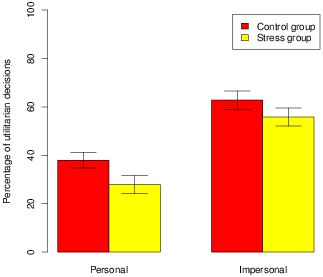
Results of the ANOVA with repeated measures for decisions and reaction times are shown in Table 2. Concerning the percentage of utilitarian decisions, the effect that was found for the factor “dilemma” suggests that participants more often decided on a utilitarian basis in impersonal than in personal dilemmas (mean personal = 33.06%, SD = 17.94%; mean impersonal = 59.39%, SD = 17.49%); the effect for the factor “group” indicates that the stress group made fewer utilitarian decisions compared to the control group (mean stress group = 41.88%, SD = 13.58%; mean control group = 50.40%, SD = 14.85%). Interaction between both factors did not reach significance. This is emphasized by post-hoc between-group comparisons that revealed a moderate effect (see Cohen, 1988) for both kinds of dilemmas (d personal = .58; d impersonal = .40). Results can be seen in Figure 2.
Reaction time data were log-transformed before conducting ANOVAs because they were skewed. In order to present absolute values, the original descriptive values are presented in brackets in the text (in milliseconds; ms). The effect found for the factor “group” indicates that participants of the stress group needed longer to make a decision compared to the control group (mean stress group = 7148.59 ms, SD = 2331.83 ms; mean control group = 5291.01 ms, SD = 1393.03 ms) and the effect for the factor “judgment” indicates that participants needed longer to make a utilitarian decision compared to a non-utilitarian decision (mean utilitarian = 6613.81 ms, SD = 2574.48 ms; mean non-utilitarian = 5888.64 ms, SD = 2105.53 ms).
The inclusion of positive and negative affect as covariates did not influence the main effects. The covariates (baseline- and post-manipulation positive and negative affect and changes in positive and negative affect after the manipulation) did not reach significance (all p‘s > .05).
We subtracted the scores for baseline heart rate from the scores for heart rate during manipulation in order to have an indicator of the individual physiological stress response. This score was correlated with the percentage of utilitarian judgments for all participants and for the two groups separately. Overall, heart rate increase was negatively related to the percentage of utilitarian decisions (r = –.42, p < .005). This relationship was significant in the stress group (r = –.43, p < .05) with a moderate effect size (Cohen, 1988), whereas it failed to reach significance in the control group (r = –.26, p = .20) for which the effect size was rather low. Note, however, that Fisher’s z-transformed correlation coefficients did not statistically differ from each other (z = –.64, p = .26).
In line with the study of Youssef et al. (in press) participants exposed to an acute stressor made fewer utilitarian judgments compared to unstressed participants and individual physiological stress response was related to non-utilitarian judgments. Thus, two of their main results could be replicated and generalized with respect to a different kind of stressor (anticipated speech instead of actual speech and arithmetic) and a different kind of stress measurement (heart rate increase instead of cortisol).
By comparing our results with those of previous studies in more detail, there are, however, also conflicting points. While Youssef et al. did not find a difference in response times between stressed and unstressed participants, in the current study the stressed participants needed longer to make a decision. This can possibly be attributed to the kind of stressor. In the previous study, a stress induction with an actual speech prior to the moral decision-making task was used, whereas the current study used the announcement of a speech subsequent to the decision-making task. Participants anticipating a speech after the task may have expected that they have to justify their responses in the speech. Thus, the stressor may have elicited feelings of accountability (see Tetlock, 1992 for a more detailed description of accountability). However, a follow up study including 64 participants indicates that feelings of accountability alone are not sufficient to explain the results of the current study (Starcke, unpublished results). In the follow up study, participants of the accountability group were told that they had to explain their responses towards the investigator after they had finished the task, while the participants of the control group were not exposed to this manipulation. Groups did neither differ in their moral judgments nor in their reaction times.
A second difference compared to the results of Youssef et al. (in press) is that, in the current study, stressed participants made fewer utilitarian judgments in personal and impersonal dilemmas whereas in the previous study of Youssef et al., only personal dilemmas were affected by stress. Recent studies that investigated moral judgments in healthy participants who were exposed to some kind of cognitive pressure during task performance also found selective effects of stress on judgments in personal dilemmas. Suter and Hertwig (2011) found a decrease in utilitarian judgments under time pressure; Greene et al. (2008) reported an increase in decision times for utilitarian judgments under cognitive load induced by a secondary task. This divergence might be due to methodological reasons. A methodological difference to the previous studies is the selection of dilemmas. Greene et al. (2008) subdivided the personal dilemmas into high-conflict (see Koenigs et al., 2007) and low-conflict dilemmas. They focused on personal high-conflict dilemmas in which the cognitive load selectively led to prolonged reaction times in utilitarian judgments. In impersonal dilemmas, reaction times were also higher under cognitive load, but not selectively when utilitarian judgments were made, whereas personal low-conflict dilemmas were not affected. While in this study cognitive load did not affect the judgments themselves, Suter and Hertwig found that time pressure had decreasing effects on the number of utilitarian judgments. In accordance with the study of Greene et al., the effect was observed in personal high-conflict dilemmas selectively. In the current study, the particular effect on personal high-conflict dilemmas could not be analyzed because personal dilemmas were not systematically chosen according to high- or low-conflict. Note however, that Youssef et al. (in press) did not particularly choose high-conflict dilemmas either but selected dilemmas randomly and also found that personal dilemmas are affected by stress selectively. Nevertheless, current findings do not principally contradict the assumed underlying processes: Cognitive resources required for utilitarian judgments are necessary for impersonal dilemmas as well, albeit the conflict between intuitive responses and utilitarian judgment is supposed to be less pronounced.
As an underlying mechanism for fewer utilitarian judgments and longer reaction times we suppose that stress inhibits cognitive control which is necessary to override initial emotional responses. Recent research suggests that acute stress can impair attention (Elling et al., 2011; Simoens et al., 2007), working memory (Duncko, Johnson, Merikangas, & Grillon, 2009; Schoofs, Preuss, & Wolf, 2008), and information search strategies (Keinan, 1987). Each of these processes is necessary to make a cognitively based utilitarian decision. Current results are in line with recent studies investigating the effect of stress on decision making unrelated to morality. Stress (including the same cognitive demand as in the current study) and pure cognitive load (1- or 2-back memory task to be performed simultaneously) led to dysfunctional decisions in a gambling task requiring outcome calculation (Starcke, Pawlikowski, Wolf, Altstötter-Gleich, & Brand, 2011; Starcke et al., 2008).
Several limitations of the current results due to the kind of stressor, the kind of sample and the procedures used have to be kept in mind: The laboratory stressor used in the current study probably causes weaker stress reactions than certain real life stressors (e.g., bullying, death of a relative) or the experience of a real life moral dilemma (e.g., the decision to take a terminally ill patient off a life support machine). Thus, the possibility still exists that real life moral dilemmas promote stronger stress reactions (Kälvemark et al., 2004) which in turn may influence subsequent decisions. Furthermore, the sample consisted of highly educated university students who might respond to moral dilemmas in a more sophisticated way than other population groups. Thus, students might not respond predominantly according to their feelings but they may have a more cognitive access to the dilemmas. Therefore, dilemmas might be especially prone to cognitive interferences in our particular sample. The finding that controlling for positive and negative affect did not influence the main effects also supports this assumption. At first sight, the non-significant findings contradict previous studies (Strohminger, Lewis, & Meyer, 2011; Valdesolo & DeSteno, 2006) that found an influence of affect on moral decision making. However, in both previous studies affect was manipulated directly while in the current study it was only assessed as a covariate.
In summary, our results indicate that anticipatory stress leads to a decrease in the number of utilitarian judgments; it leads to longer reaction times; and physiological stress reactions are related to non-utilitarian judgments. Results are basically congruent with previous studies which investigated the effect of acute stress or cognitive demand on moral judgments indicating an inhibition of cognitive control which is required to make a utilitarian decision.
Bechara, A., Tranel, D., & Damasio, H. (2000). Characterization of the decision-making deficit of patients with ventromedial prefrontal cortex lesions. Brain, 123, 2189–2202.
Brand, M., Fujiwara, E., Borsutzky, S., Kalbe, E., Kessler, J., & Markowitsch, H. J. (2005). Decision-making deficits of Korsakoff patients in a new gambling task with explicit rules: associations with executive functions. Neuropsychology, 19, 267–277.
Cannon, W. B. (1914). The emergency function of the adrenal medulla in pain and the major emotions. American Journal of Physiology, 33, 356–372.
Cohen, J. (1988). Statistical power analysis for the behavioral sciences (2nd ed.). Hillsdale, NJ: Erlbaum.
Duncko, R., Johnson, L., Merikangas, K., & Grillon, C. (2009). Working memory performance after acute exposure to the cold pressor stress in healthy volunteers. Neurobiology of Learning and Memory, 91, 377–381.
Elling, L., Steinberg, C., Bröckelmann, A.-K., Dobel, C., Bölte, J., & Junghofer, M. (2011). Acute stress alters auditory selective attention in humans independent of HPA: a study of evoked potentials. PLoS ONE, 6, e18009.
Greene, J. D., Morelli, S. A., Lowenberg, K., Nystrom, L. E., & Cohen, J. D. (2008). Cognitive load selectively interferes with moral judgment. Cognition, 107, 1144–1154.
Greene, J. D., Nystrom, L. E., Engell, A. D., Darley, J. M., & Cohen, J. D. (2004). The neural bases of cognitive conflict and control in moral judgment. Neuron, 44, 389–400.
Greene, J. D., Sommerville, R. B., Nystrom, L. E., Darley, J. M., & Cohen, J. D. (2001). An fMRI investigation of emotional engagement in moral judgment. Science, 293, 2105–2108.
Haidt, J. (2007). The new synthesis in moral psychology. Science, 316, 998–1002.
Heineken, E., Schulte, F. P., & Ollesch, H. (2003). Experimentalpsychologische Ausbildung im virtuellen Labor: Das Laboratorium für Online-Research (Lab.Or.) (Vol. IV). Bonn: Deutscher Psychologen Verlag.
Horn, W. (1983). Leistungsprüfsystem. Göttingen: Hogrefe.
Kälvemark, S., Höglund, A. T., Hansson, M. G., Westerholm, P., & Arnetz, B. (2004). Living with conflicts-ethical dilemmas and moral distress in the health care system. Social Science and Medicine, 58, 1075–1084.
Keinan, G. (1987). Decision making under stress: scanning of alternatives under controllable and uncontrollable threats. Journal of Personality and Social Psychology, 52, 639–644.
Kirschbaum, C., Pirke, K. M., & Hellhammer, D. H. (1993). The “Trier Social Stress Test”—a tool for investigating psychobiological stress responses in a laboratory setting. Neuropsychobiology, 28, 76–81.
Koenigs, M., Young, L., Adolphs, R., Tranel, D., Cushman, F., Hauser, M., & Damasio, A. (2007). Damage to the prefrontal cortex increases utilitarian moral judgements. Nature, 446, 908–911.
Lighthall, N. R., Mather, M., & Gorlick, M. A. (2009). Acute Stress Increases Sex Differences in Risk Seeking in the Balloon Analogue Risk Task. PLoS ONE, 4.
Preston, S. D., Buchanan, T. W., Stansfield, R. B., & Bechara, A. (2007). Effects of anticipatory stress on decision-making in a gambling task. Behavioral Neuroscience, 121, 257–263.
Schoofs, D., Preuss, D., & Wolf, O. T. (2008). Psychosocial stress induces working memory impairments in an n-back paradigm. Psychoneuroendocrinology, 33, 643–653.
Schulz, P., Schlotz, W., & Becker, P. (2004). Trierer Inventar zum Chronischen Stress (TICS). Göttingen: Hogrefe.
Selye, H. (1956). The stress of life. New York: McGraw-Hill.
Simoens, V. L., Istók, E., Hyttinen, S., Hirvonen, A., Näätänen, R., & Tervaniemi, M. (2007). Psychosocial stress attenuates general sound processing and duration change detection. Psychophysiology, 44, 30–38.
Spielberger, C. D., Gorsuch, R. L., Lushene, R. E., Vagg, P. R., & Jacobs, G. A. (1977). Stait-Trait Anxiety Inventory for Adults. Redwood City: Mind Garden.
Starcke, K., Pawlikowski, M., Wolf, O. T., Altstötter-Gleich, C., & Brand, M. (2011). Decision-making under risk conditions is susceptible to interference by a secondary executive task. Cognitive Processing, 12, 177–182.
Starcke, K., Polzer, C., Wolf, O. T., & Brand, M. (2011). Does stress alter everyday moral decision-making? Psychoneuroendocrinology, 36, 210–219.
Starcke, K., Wolf, O. T., Markowitsch, H. J., & Brand, M. (2008). Anticipatory stress influences decision making under explicit risk conditions. Behavioral Neuroscience, 122, 1352–1360.
Strohminger, N., Lewis, R. L., & Meyer, D. E. (2011). Divergent effects of different positive emotions on moral judgment. Cognition, 119, 295–300.
Suter, R. S., & Hertwig, R. (2011). Time and moral judgment. Cognition, 119, 454–458.
Tetlock, P. E. (1992). The impact of accountability on judgment and choice: Toward a social contingency model. Advances in Experimental Social Psychology, 25, 331–376.
Valdesolo, P., & DeSteno, D. (2006). Manipulations of emotional context shape moral judgment. Psychological Science, 17, 476–477.
van den Bos, R., Harteveld, M., & Stoop, H. (2009). Stress and decision-making in humans: Performance is related to cortisol reactivity, albeit differently in men and women. Psychoneuroendocrinology, 34, 1449–1458.
Watson, D., Clark, L. A., & Tellegen, A. (1988). Development and validation of brief measures of positive and negative affect: the PANAS scales. Journal of Personality and Social Psychology, 54, 1063–1070.
Wiegmann, A., Okan, Y., Nagel, J., & Mangold, S. (2010). Order effects in moral judgment. Paper presented at the Proceedings of the Thirty-Second Annual Conference of the Cognitive Science Society, Austin, TX.
Youssef, F. F., Dookeeram, K., Basdeo, V., Francis, E., Doman, M., Mamed, D., Maloo, S., Degannes, J., Dobo, L., Ditshotlo, P., & Legall, G. (in press). Stress alters personal moral decision making. Psychoneuroendocrinology.
For the current study, 20 dilemmas were selected from a set of moral dilemmas mostly developed and used by Greene et al. (2004).1 Half of the dilemmas were personal; the other half was of impersonal nature. All dilemmas had to be answered with “yes” or “no”; the answer “yes” always represents the utilitarian decision, the answer “no” always represents the non-utilitarian decision.
Proportion of utilitarian judgments and
reaction times in personal dilemmas for each dilemma separately.
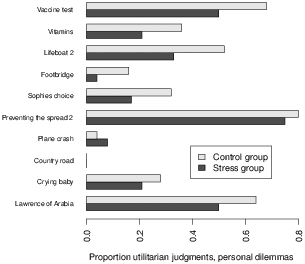
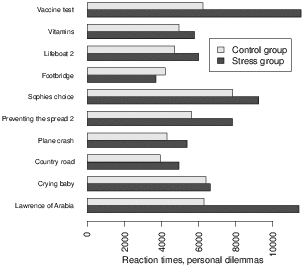
Proportion of utilitarian judgments and reaction times in
impersonal dilemmas for each dilemma separately.
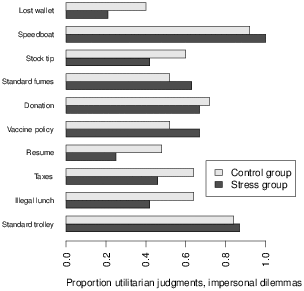
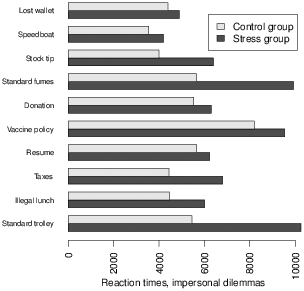
Baron, J. (1998). Judgment misguided. New York: Oxford University Press.
Foot, P. (1978). Virtues and vices. Berkeley: University of California Press.
Greene, J. D., Nystrom, L. E., Engell, A. D., Darley, J. M., & Cohen, J. D. (2004). The neural bases of cognitive conflict and control in moral judgment. Neuron, 44, 389–400.
Thomson, J. (1986). Rights, restitution and risk. Cambridge: Harvard University Press.
Unger, P. (1996). Living high and letting die. New York: Oxford University Press.
This document was translated from LATEX by HEVEA.